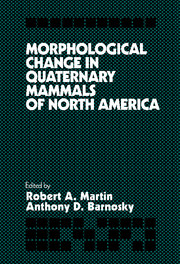Book contents
- Frontmatter
- Contents
- List of Contributors
- Acknowledgments
- 1 Quaternary mammals and evolutionary theory: introductory remarks and historical perspective
- 2 A method for recognizing morphological stasis
- 3 Mosaic evolution at the population level in Microtus pennsylvanicus
- 4 Variogram analysis of paleontological data
- 5 Morphological change in Quaternary mammals: a role for species interactions?
- 6 Rates of evolution in Plio-Pleistocene mammals: six case studies
- 7 Patterns of dental variation and evolution in prairie dogs, genus Cynomys
- 8 Quantitative and qualitative evolution in the giant armadillo Holmesina (Edentata: Pampatheriidae) in Florida
- 9 Evolution of mammoths and moose: the Holarctic perspective
- 10 Evolution of hypsodonty and enamel structure in Plio-Pleistocene rodents
- 11 Patterns of variation and speciation in Quaternary rodents
- 12 Decrease in body size of white-tailed deer (Odocoileus virginianus) during the late Holocene in South Carolina and Georgia
- 13 Short–term fluctuations in small mammals of the late Pleistocene from eastern Washington
- 14 Size change in North American Quaternary jaguars
- 15 Ontogenetic change of Ondatra zibethicus (Arvicolidae, Rodentia) cheek teeth analyzed by digital image processing
- 16 Morphological change in woodrat (Rodentia: Cricetidae) molars
- Index
16 - Morphological change in woodrat (Rodentia: Cricetidae) molars
Published online by Cambridge University Press: 15 December 2009
- Frontmatter
- Contents
- List of Contributors
- Acknowledgments
- 1 Quaternary mammals and evolutionary theory: introductory remarks and historical perspective
- 2 A method for recognizing morphological stasis
- 3 Mosaic evolution at the population level in Microtus pennsylvanicus
- 4 Variogram analysis of paleontological data
- 5 Morphological change in Quaternary mammals: a role for species interactions?
- 6 Rates of evolution in Plio-Pleistocene mammals: six case studies
- 7 Patterns of dental variation and evolution in prairie dogs, genus Cynomys
- 8 Quantitative and qualitative evolution in the giant armadillo Holmesina (Edentata: Pampatheriidae) in Florida
- 9 Evolution of mammoths and moose: the Holarctic perspective
- 10 Evolution of hypsodonty and enamel structure in Plio-Pleistocene rodents
- 11 Patterns of variation and speciation in Quaternary rodents
- 12 Decrease in body size of white-tailed deer (Odocoileus virginianus) during the late Holocene in South Carolina and Georgia
- 13 Short–term fluctuations in small mammals of the late Pleistocene from eastern Washington
- 14 Size change in North American Quaternary jaguars
- 15 Ontogenetic change of Ondatra zibethicus (Arvicolidae, Rodentia) cheek teeth analyzed by digital image processing
- 16 Morphological change in woodrat (Rodentia: Cricetidae) molars
- Index
Summary
Woodrat (Rodentia: Cricetidae) molars have a number of features that have exhibited morphological change over geological time. These changes have included modification of the occlusal pattern, with a corresponding change in direction of mastication, increasing depth of the reentrant folds, development of dentine tracts, and increasing numbers of anatomical roots. These features and their variations over time can be useful in differentiating between taxa and may have some biostratigraphic and phylogenetic significance as well.
Woodrats have been reported from deposits of Hemphillian age in Texas (Dalquest, 1983) and Kansas (Hibbard, 1967); however, those samples were so small (N = 2 in each case) that there was little basis for comparison with younger specimens. Therefore, this study is based on characters and changes observed among Blancan and younger woodrats. Likewise, this study should be considered preliminary, as many more fossil and extant samples need to be examined in detail. However, I hope the information provided herein will be of benefit by delimiting characters and patterns that can be considered by others in subsequent studies.
Appendix A contains a list of fossil woodrats. Included in this list is the name of the fauna from which the fossil was obtained, the location and age of the fauna, the basis for the age assignment, and a primary reference. I have attempted to list all records of extinct species. Representative occurrences of extant species are taken from Harris (1985) and Kurtén and Anderson (1980).
- Type
- Chapter
- Information
- Morphological Change in Quaternary Mammals of North America , pp. 392 - 410Publisher: Cambridge University PressPrint publication year: 1993
- 6
- Cited by

